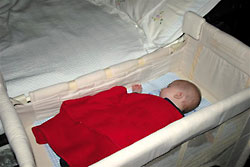|
|
|
|

Baby/Pregnancy
Safer Sleep for Babies: The Hidden Risks of
Co-Sleeping
By Jennifer Lawson
June/July 2004
When it comes to child safety,
things are never as simple as they appear: even seemingly innocuous
objects or habits can become
dangerous when there is a baby in the house. Warnings are placed
on everything from pacifiers to shopping bags and parents begin
to feel assailed by the barrage of information coming at them
from all directions. As tempting as it might seem to just throw
up your hands and let down your guard, ultimately the time and
effort it takes to prevent a potential tragedy is always worth
it.

The safest place for any baby is in his
or her own sleeping space. Most major retailers carry side-sleepers,
which attach to the bed but provide a safe, separate space. |
Such is the case with co-sleeping – the simple, natural act of sleeping
with one’s baby that has been done for hundreds of years and in many
cultures. Co-sleeping boasts many benefits such as building a closer bond
between the baby and caregiver and providing easier access for nighttime
feedings.
Additionally, many people are under the incorrect assumption that co-sleeping
reduces the risk of SIDS (Sudden Infant Death Syndrome) but unfortunately,
if not done correctly, it can actually become the cause of death.
Clarke County Coroner Randy Garrett has the grim task of examining
the bodies of babies who die suddenly in their sleep and has seen
one too many cases in
the past few years where the cause of death has been attributed to co-sleeping.
Garrett stresses that there is nothing wrong with co-sleeping in and of itself;
rather, it is a matter of each family creating a safe way to co-sleep. Even
if it means keeping a baby in a car seat that is on the bed, the important
thing to remember is that a baby needs his or her own separate and safe sleeping
space to avoid suffocation.
After reviewing the cases of several co-sleeping-related deaths,
the Clarke County Child Fatality Review Panel decided to create
a sub-committee to address
the potential hazards of co-sleeping. Randy Garrett, along with other area
child professionals, is on this committee and they have come out with a
list of things that should and should not be done when co-sleeping
with a baby.
Basically, the same rules that apply to any sleeping situation for a baby
apply to co-sleeping but there are a few additional things to consider.
Let’s
first take a look at some general guidelines for safe sleep for babies:
- Always place a baby on his or her back to sleep. Even if you
are worried about a baby spitting up, that risk is minimal in
comparison
to the risks from
a
stomach-sleeping position.
- Always place a baby on a firm surface to
sleep. Baby mattresses are made specifically for this purpose,
as are current bassinets, cradles, cribs
and playpens. Couches,
waterbeds, comforters, pillows and even stuffed animals and toys that
are in a crib can cause suffocation.
- Make sure the baby’s head stays uncovered during sleep.
Again, pillows, blankets, comforters, toys and any other object
can become
suffocation hazards
for a baby.
- Do not let the baby get too warm during sleep. Studies
have shown a strong relationship between overheating and SIDS.
- Do
not allow smoking around a baby. This advice holds true for any
person, of course, as there is a high incidence of accidental
fires attributed
to smoking in bed.
- Don’t forget to inform any relative, babysitter or
caregiver of all of these rules as well. Garrett has seen several tragic cases
where parents were
careful to follow safe guidelines but an unknowing caregiver did
not.
If you make the decision to co-sleep with a baby, follow all of the
above rules and in addition:
- Use a large (queen or king-size) bed
or other firm bedding and check to make sure there are no gaps (between
the headboard or footboard and
mattress, for
example) or nearby furniture (night tables, etc.). If you are
using something to keep the baby from rolling off the bed, make
sure it has slats
that are
very close together or is constructed of a safe, mesh-type material.
Make sure the mattress that you are using is the right size for the bed
frame so that
the baby cannot get stuck between the bed and frame.
- Rather than
putting the baby in the middle of two adults, place the baby
only next to the mother.
- Dress the baby in a sleeper instead
of using heavy blankets.
- Never sleep with a baby if you are under
the influence of any drugs or alcohol (even prescription drugs
or cold medicine).
- Do not sleep with a baby if you are very overweight.
- Do not
sleep with a baby if you are extremely tired and suffering from
a lack of sleep.
- Do not allow other children or babysitters to
sleep with the baby.
- Do not fall asleep with the baby on a couch
or other soft surface.
Q&A with
Paula Shilton, the Director of the AACAPC (Athens Area Child
Abuse Prevention Council) which, as part
of their abuse prevention effort, provides programs to support
and educate area parents. Paula Shilton is a member of the
co-sleeping sub-committee which has compiled information on
safer sleep for babies. This information will soon be available
in a brochure produced and funded by the Athens-Oconee Woman’s
Club.
Q: What
do you say in response to comments such as, “People
have been co-sleeping with their babies since the dawn of
time,” or “They do it all the time in European
countries?”
A: Absolutely true, but
the modern American way of sleeping isn’t usually the same as in other countries or in
earlier times. In Japan, for example, co-sleeping is very
common and there is a low rate of deaths attributed to co-sleeping.
If Americans slept on a firm futon on the floor, with simple
bedding (and weren’t overweight), co-sleeping would
probably be safer.
Q: Since
it is not safe to fall asleep with a baby if you are over-tired,
then wouldn’t
most parents of a baby fall into that category because
they are tired from night-time
feedings, etc. Is it ever really safe to fall asleep with
a baby?
A: Parents make tough choices
every day. It would probably be the most tempting to put
your baby in bed with you after
several nights of getting no sleep, if that seemed to quiet
the baby – and yet that could be the riskiest time.
As the mother of three kids, I know that babies cry a lot
and keep their parents awake, but fortunately, babies do
sleep more and cry less as they grow.
Q: What is a good, safe alternative
for parents who might not be able to afford a crib, bassinet,
or side-sleeper for
their bed?
A: Unfortunately, there isn’t a magic solution – an
inexpensive item of sleeping equipment that is guaranteed
to be safe. It’s all in how your sleep space is used.
A dresser drawer placed on the floor could be safe, but parents
might try to make it softer with comforters and pillows – both
hazardous for babies. I would try to find a used crib or
bassinet and check it for safety. It should have either mesh
sides or slats that are close enough together that a can
of soda (lying on its side) can’t fit through.
|
Have an alternative set-up in place so that you have options for
those inevitable nights in which you are exhausted or in need
of a medicine that might make you unusually tired. The safest place
for any baby is in his or her own sleeping space. Most major
retailers
carry side-sleepers, which attach to the bed but provide a safe,
separate space. Placing the crib or bassinet in your bedroom
is another safe alternative that allows for closeness as well as
safety.
If you cannot afford to buy a new crib or side-sleeper, check
the Salvation Army, Potter’s House or the Athens Pregnancy
Center. As with all used baby furniture, be sure to check for slats
that
are close together, no peeling paint, etc.
At one time or another, just about every parent of a baby will
fall into one of the dangerous scenarios listed above. Try to think
of safe sleeping in the same way that you think about car safety
for your child: you wouldn't put your baby in car without a proper
child seat and seatbelt, even for a short ride. Likewise, if parents
aren’t vigilant about their baby’s sleep environment,
infant suffocation can happen in the blink of an eye. If in doubt,
check with your pediatrician for more information about safe sleeping
or call the Public Health Information Line at 1-800-4PD-HELP (473-4357).
|
|
. |




